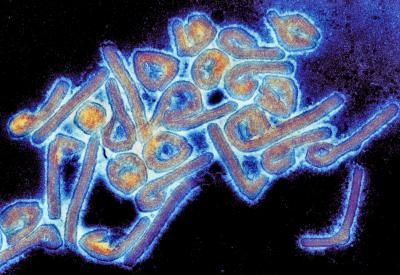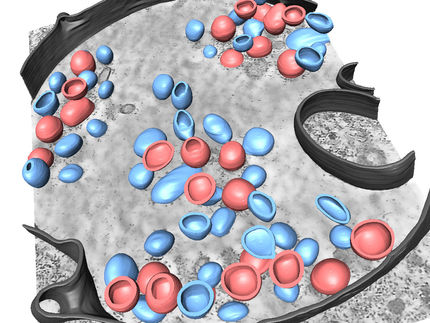UTMB researchers develop treatment effective against lethal Marburg virus
New countermeasure successfully protects nonhuman primates from Marburg 3 days after infection
For the first time, researchers at the University of Texas Medical Branch at Galveston, in collaboration with Tekmira Pharmaceuticals, have protected nonhuman primates against Marburg virus – Angola hemorrhagic fever. Their treatment was shown to be effective at a point when animals have detectable levels of the virus in their system and begin to show symptoms of the disease. The study appeared in the August 20 edition of the journal Science Translational Medicine.

This is an electron microscope photo of the Marburg virus.
Thomas Geisbert, University of Texas Medical Branch
There are currently no vaccines or drugs approved for human use and no post-exposure treatment that has completely protected nonhuman primates against MARV-Angola, the most deadly Marburg viral strain, with a mortality rate of up to 90 percent. This virus, which is in the same family as Ebola, has a rapid disease course (seven to nine days) in nonhuman primates. There have been two recent imported cases of MARV HF to Europe and the United States, further increasing concern regarding the public health threat posed by this deadly virus.
"The increasingly frequent outbreaks of filoviral HF in Africa evidenced by the current rapidly spreading outbreak in Guinea, Liberia and Sierra Leone illustrate the clear and present danger filoviruses represent to human health," stated UTMB's Thomas Geisbert, professor of microbiology and immunology. "As such, the development of effective countermeasures against these viruses is a critical need."
Previous studies with nonhuman primates have examined countermeasures against MARV infection at times before the subjects showed any evidence of clinical illness. This goal of this study, led by Geisbert and Ian MacLachlan, executive vice president and chief technical officer of Tekmira Pharmaceuticals, was to determine whether it is possible to protect animals against a lethal MARV-Angola infection when treatment was started at a point when animals have detectable levels of the virus in their system and show the first clinical signs of disease.
Their strategy centered on the MARV RNA genome that encodes for seven structural proteins, two of which are responsible for replicating the genome. These seven genes and their products represent targets for the development of therapeutic agents and vaccines against MARV.
The research team demonstrated that their lipid encapsulated small interfering RNA treatment completely protected nonhuman primates against lethal MARV-Angola HF when treatment began even up to three days following infection.
"The significance of delaying treatment until three days after infection, which is the earliest time at which diagnosis by viral RNA can be detected and those infected show the first clinical signs of disease, is a critical step in triggering clinical interventions," stated MacLachlan.
Organizations
Other news from the department science

Get the life science industry in your inbox
From now on, don't miss a thing: Our newsletter for biotechnology, pharma and life sciences brings you up to date every Tuesday and Thursday. The latest industry news, product highlights and innovations - compact and easy to understand in your inbox. Researched by us so you don't have to.




















































